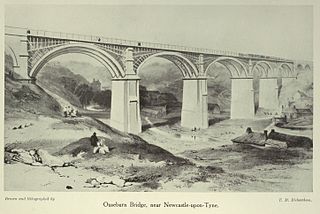
Howdon is a Tyne and Wear Metro station, serving the suburb of Howdon, North Tyneside in Tyne and Wear, England. It joined the network on 14 November 1982, following the opening of the fourth phase of the network, between Tynemouth and St James via Wallsend.

The Tyneside Electrics were the suburban railways on Tyneside that the North Eastern Railway and the London and North Eastern Railway electrified using the third rail system. The North Tyneside Loop was electrified from 1904 onwards and formed one of the earliest suburban electric networks; the South Tyneside line to South Shields via Pelaw was electrified in March 1938. British Railways converted these lines to diesel operation in the 1960s: the line to South Shields in January 1963 and the North Tyneside lines in June 1967 when the electrical supply infrastructure and the rolling stock had become life expired. In addition, the system was losing passengers and suffering from costly vandalism. Since the late 1970s, much of the system has been converted to form the Tyne and Wear Metro.
The North Tyneside Loop refers to the railway lines in North Tyneside from Newcastle upon Tyne via Wallsend, North Shields, Whitley Bay, Backworth, Benton and South Gosforth back to Newcastle. Since the 1980s, it has formed part of the Tyne and Wear Metro, albeit in modified form.

The Newcastle & North Shields Railway opened in June 1839 from a temporary terminus in Carliol Square in Newcastle upon Tyne to North Shields. The railway was absorbed by the Newcastle & Berwick Railway in November 1844. The Newcastle & Berwick Railway was itself absorbed by the York, Newcastle and Berwick Railway, and this became part of the North Eastern Railway in 1854.

Tynemouth is a Tyne and Wear Metro station, serving the coastal town of Tynemouth, North Tyneside in Tyne and Wear, England. It joined the network as a terminus station on 11 August 1980, following the opening of the first phase of the network, between Haymarket and Tynemouth via Four Lane Ends.

Carville Power Station refers to a pair of now partially demolished coal-fired power stations, situated in North East England on the north bank of the River Tyne at Wallsend. The two stations were built alongside each other on a riverside site about 5 mi (8.0 km) downstream of Newcastle upon Tyne. Carville A Power Station, the first station on the site was opened in 1904, and Carville B Power Station was opened in 1916 to its south.

Alston is a heritage railway station on the South Tynedale Railway. The station, situated 13 miles (21 km) south of Haltwhistle, is in the market town of Alston, Eden in Cumbria, England.
The Riverside Branch was a 6+1⁄2-mile (10.5 km) double-track branch line, which ran between Riverside Junction in Heaton and Percy Main West Junction in Percy Main.

The Tyne Valley Line is a 58-mile (93 km) route, linking Newcastle upon Tyne with Hexham and Carlisle. The line follows the course of the River Tyne through Tyne and Wear and Northumberland. Five stations and two viaducts on the route are listed structures.

The Scotswood, Newburn and Wylam Railway was a railway company that built the 6+1⁄2 miles (10.5 km) North Wylam branch or North Wylam loop on the former Newcastle & Carlisle Railway. The loop line opened between 1871 and 1876 and followed the former Wylam waggonway past the cottage where George Stephenson was born. The company was taken over by the North Eastern Railway in 1883.

The Ponteland Railway was a 7-mile (11 km) single-track branch line, which linked Gosforth in Tyne and Wear with Ponteland in Northumberland. A 1+1⁄4-mile (2 km) sub-branch line also ran between Ponteland and Darras Hall.

Redmarshall railway station was a railway station on the North Eastern Railway, in County Durham.
Walker was a railway station on the Riverside Branch which ran between Byker and Willington Quay. The station served Walker in Newcastle upon Tyne.

Byker was a railway station on the Riverside Branch, which ran between Byker and Willington Quay. The station served Byker in Newcastle upon Tyne.
Point Pleasant was a railway station on the Riverside Branch, which ran between Byker and Willington Quay. The station served Willington Quay in North Tyneside.

Lambley was a railway station on the Alston Branch Line, which ran between Haltwhistle and Alston. The station, situated 4+3⁄4 miles (8 km) south-west of Haltwhistle, served the village of Lambley in Northumberland.
Willington Quay was a railway station on the Riverside Branch, which ran between Byker and Willington Quay. The station served Willington Quay in North Tyneside.
St. Anthonys was a railway station on the Riverside Branch, which ran between Byker and Willington Quay. The station served Walker in Newcastle upon Tyne.
St. Peters was a railway station on the Riverside Branch, which ran between Byker and Willington Quay. The station served Byker in Newcastle upon Tyne.

Coanwood was a railway station on the Alston Branch Line, which ran between Haltwhistle and Alston. The station, situated 4 miles (6 km) south-west of Haltwhistle, served the village of Coanwood in Northumberland.













